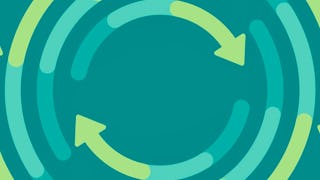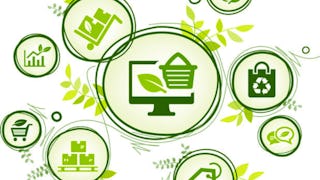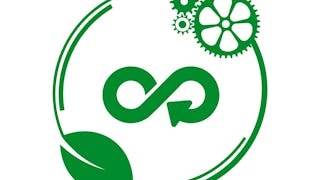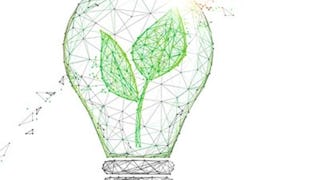This first course in the Sustainable and Circular Product Development specialization illustrates the product design tools necessary to implement Circular Economy (CE) principles. The course begins with an overview of the Circular Economy and why it is necessary today. It then discusses the design strategies involving Design for the Environment (DfE) and Design for “R”, where R refers to Reuse, Repair, Remanufacturing, and Recycling. This course goes deeper into the world of recycling, highlighting what happens at a Material Recovery Facility, or MRF, and the innovative sorting technologies recently developed to make recycling more cost-effective. Finally, the course shows the correlation between population, affluence and consumption patterns, and how that limits the availability of materials for products, emphasizing the subsequent importance of a circular economy. The course ends by highlighting ways product designers can select the appropriate materials to achieve circularity objectives and make eco-informed decisions.


Product Design for the Circular Economy
包含在  中
中
您将学到什么
Describe the concept of the Circular Economy and why it is necessary today.
Explain the difference between linear and circular product design using Design for R strategies.
Describe how organic (e.g., natural) materials enable a circular economy through the biological cycle.
Apply materials selection tools to achieve circular product objectives.
您将获得的技能
要了解的详细信息

添加到您的领英档案
18 项作业
了解顶级公司的员工如何掌握热门技能

积累特定领域的专业知识
- 向行业专家学习新概念
- 获得对主题或工具的基础理解
- 通过实践项目培养工作相关技能
- 获得可共享的职业证书

该课程共有5个模块
Welcome to "Product Design for the Circular Economy", the first course of the Sustainable and Circular Product Development Specialization. The course starts by introducing you to the concept of the Circular Economy and how it differs from the linear economic practices of today. After discussing how the linear economy is challenged to support 8 Billion people on the planet, you'll explore the three basic principles of the circular economy, and how it decouples economic growth from resource extraction. You'll discover the work of the Ellen MacArthur Foundation and their Circular Economy Butterfly Diagram in detail, which provides many examples of how to put sustainability and circularity into practice. You'll conclude this module by comparing conventional product design in several case studies.
涵盖的内容
13个视频13篇阅读材料4个作业1个讨论话题
Designing products with environmental responsibility in mind has traditionally been known as DfE: Design for the Environment. In this module, you'll learn that this has typically involved measures such as Design for Dematerialization (lightweighting), Design for Detoxication (safe materials), and Design for Revalorization (product recovery). The Circular Economy model goes beyond this to ensure the product is durable and long-lived, easily repairable and upgradeable. These elements drive product design - the primary topic of this module. Design for R introduces you incorporating design elements that prioritize remanufacturing and recyclability or compostability. The module then concludes with examples of how these design protocols can be implemented in practice.
涵盖的内容
9个视频3篇阅读材料4个作业1次同伴评审
This module presents a deep-dive into recycling. Although it is the last stop in a product's life cycle, it is the one that provides the raw materials for the next production cycle. To be fully recyclable, products need to be designed with recycling in mind. This module discusses the important factors of how to Design for Recycling. This includes a focus on disassembly and material selection. You'll learn how materials can directly effect a product's lifecycle and utility. For example, aluminum is an infinitely recyclable raw material source, while plastic on the other hand, degrades each time it is recycled, and often ends up in a product that is "downcycled", meaning a product of lower value. To tackle the topic of excess waste, especially from plastic, you'll learn from a prominent chemical engineer that recovery is possible. At a Material Recovery Facility (MRF) where recycling happens, you'll learn about the technological advances in sorting that help minimize or eliminate contamination. You'll discover two startups that are advancing "sortation". Since recycled materials only become valuable if there is a market for them, you'll examine the economic factors recyclers face and their potential solutions. The module wraps up with a look to where we're at today, and how policies such as Extended Producer Responsibility can accelerate recycling, making it more competitive with virgin materials.
涵盖的内容
8个视频8篇阅读材料4个作业
This module explores the opportunities for new products based on biological nutrient cycles. Having a biological nature creates several different pathways into new products such as composting, which can later be used as a soil amendment. This module discusses what composting is and how it can be utilized for virtually any natural material. You’ll learn how natural materials digest and can produce biogas, a renewable biofuel that can be a replacement for natural gas. Finally, you’ll explore what makes a healthy biosphere in the context of prioritizing soil health with Regenerative Agriculture and Carbon Farming.
涵盖的内容
6个视频5篇阅读材料3个作业
Products are made from materials, and material selection is the starting point for any sustainable and circular product. This module begins by examining the relationship between population, affluence and materials consumption, and the challenges faced as we approach the limit of some natural resources. We then shift to materials selection from an environmental perspective, answering a question we all hear today: paper or plastic? Eco-designs must often account for constraints and tradeoffs, usually between cost, performance and environmental impact. To do this, you will learn about trade-off analysis using a 2L carbonated beverage container. As materials play a key role in the circular economy, you’ll explore the link between the challenges and opportunities of a circular material economy. The module concludes with a wrap-up that summarizes the entire course, particularly in highlighting the transition from the linear to a circular economy, and how product design is key to making that happen.
涵盖的内容
8个视频2篇阅读材料3个作业
获得职业证书
将此证书添加到您的 LinkedIn 个人资料、简历或履历中。在社交媒体和绩效考核中分享。
攻读学位
课程 是 University of Colorado Boulder提供的以下学位课程的一部分。如果您被录取并注册,您已完成的课程可计入您的学位学习,您的学习进度也可随之转移。
位教师

从 Environmental Science and Sustainability 浏览更多内容
 状态:免费试用
状态:免费试用University of Colorado Boulder
 状态:免费试用
状态:免费试用University of Colorado Boulder
 状态:免费试用
状态:免费试用University of Colorado Boulder
 状态:免费试用
状态:免费试用University of Colorado Boulder
人们为什么选择 Coursera 来帮助自己实现职业发展




常见问题
To access the course materials, assignments and to earn a Certificate, you will need to purchase the Certificate experience when you enroll in a course. You can try a Free Trial instead, or apply for Financial Aid. The course may offer 'Full Course, No Certificate' instead. This option lets you see all course materials, submit required assessments, and get a final grade. This also means that you will not be able to purchase a Certificate experience.
When you enroll in the course, you get access to all of the courses in the Specialization, and you earn a certificate when you complete the work. Your electronic Certificate will be added to your Accomplishments page - from there, you can print your Certificate or add it to your LinkedIn profile.
Yes. In select learning programs, you can apply for financial aid or a scholarship if you can’t afford the enrollment fee. If fin aid or scholarship is available for your learning program selection, you’ll find a link to apply on the description page.
更多问题
提供助学金,






